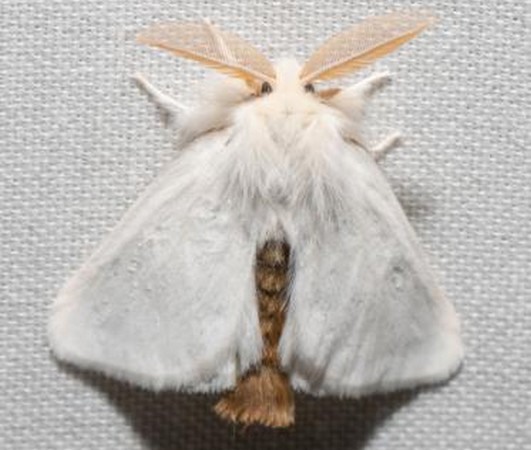The browntail moth (Euproctis chrysorrhoea) is an insect that was accidentally introduced to Massachusetts from Europe in 1897. By the early 1900s, it spread into all of New England and parts of Canada. The caterpillars of this species feed on oak, shadbush, cherry, beach plum, apple, rugosa rose, and other trees and shrubs. While the feeding damage from the caterpillars on landscape specimens may be problematic, the primary cause for concern with regard to browntail moth is medical: the caterpillars of this species possess poisonous hairs that cause a rash similar to poison ivy, and, in some sensitive individuals, may cause trouble breathing or sometimes a more severe allergic reaction.
Luckily, thanks to a suite of parasitoids and pathogens and additional factors, by the 1930s, populations of browntail moth declined below noticeable levels, in the greater part of its historical range. In particular, there are two tachinid fly parasitoids known to attack browntail moth: Compsilura concinnata and a species of Townsendiellmyia. Various wasp parasitoids will also attack browntail moth, including those in the genera Pimpla, Brachymeria, and others. An entomopathogenic fungus (Entomophaga aulicae; a different species than E. maimaiga, which attacks Lymantria dispar caterpillars) as well as an NPV virus (the Euproctis chrysorrhoea Nucleopolyhedrosis Virus; EcNPV) also impact browntail moth populations.

While there were some small outbreaks of browntail moth in the 1960s in the US, the insect has remained in low, isolated populations restricted to the Casco Bay Region of Maine and on parts of Cape Cod, Massachusetts. Since the early 1990s, localized outbreaks of browntail moth have occurred occasionally in other coastal communities in Maine. However, since 2016, Maine has experienced a significant spread of this insect within state borders. For unknown reasons, this most recent outbreak has remained restricted to parts of Maine.
While occasional sightings of this pest have occurred in coastal areas of Massachusetts over the past several years, no recent outbreaks have occurred. However, UMass Extension was recently made aware of reports of adult browntail moths coming to lights in Essex and Plymouth counties, and the iNaturalist website even has a report in the Boston area (Chestnut Hill). While the presence of adult browntail moth in locations outside of Cape Cod represents a change in the recent historical distribution of this insect in Massachusetts, we do not believe browntail moth populations are elevated or widespread in MA at this time. The MA Department of Conservation and Recreation will be completing enhanced surveys of browntail moth caterpillar webs this winter and will be providing updates on the anticipated impact of the pest next spring. However, due to the increasing population and distribution of browntail moth in Maine, recent finds of the adult moths in Massachusetts, and the medical concerns associated with this insect, we are recommending that green industry professionals working in Massachusetts, particularly in coastal areas of Barnstable, Essex, Norfolk, Plymouth, and Suffolk Counties, should review the information we provide below and be able to accurately identify this insect in all life stages. Key in this information is the note that they should avoid touching the caterpillars, pupae/cocoons, or the nests/webbing produced by this pest without protective eyewear, gloves, long sleeves, pants, and other protective clothing. When hiking or enjoying the outdoors in coastal areas, stay on trails and do not cut through shrubs to avoid incidental exposure to potential browntail moths present.
Adult browntail moths are now emerging and once they mate, will lay their eggs on leaves at the tops of host plants through the end of July. By August, these eggs will hatch and young caterpillars will feed in groups until the early fall, at which time they will build overwintering webs (hibernacula) in which they will be protected until they emerge the following April. Once these overwintered caterpillars emerge, they will feed and grow until pupation occurs, sometime at the end of June. Adult moths emerge in July, mate, and the life cycle begins again. Highly irritating hairs are present in the winter webs, through the spring and summer caterpillar and pupal stages, to the adults – however the adult moths themselves do not seem to produce irritating hairs (yet the hairs from the caterpillar and pupal stages may remain on the adults after they emerge). Because hairs can persist in webs even after caterpillar emergence, use caution and wear PPE even when handling older webs.
What to look for now (July): The adult moths are attracted to light, fly at night, and may be active into August. Adult moth wingspans are approximately 1.5 inches, with solid white wings and white abdomens with brown at the tips. In males, the brown coloration extends along most of the upper (dorsal) surface of the abdomen, while in females, much of the abdomen is white, with a much larger tuft of brown hairs at the tip. Egg masses laid by females are brown and fluffy in appearance.
For more information:
University of Massahussets Amherst
www.umass.edu
